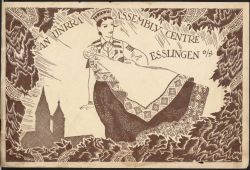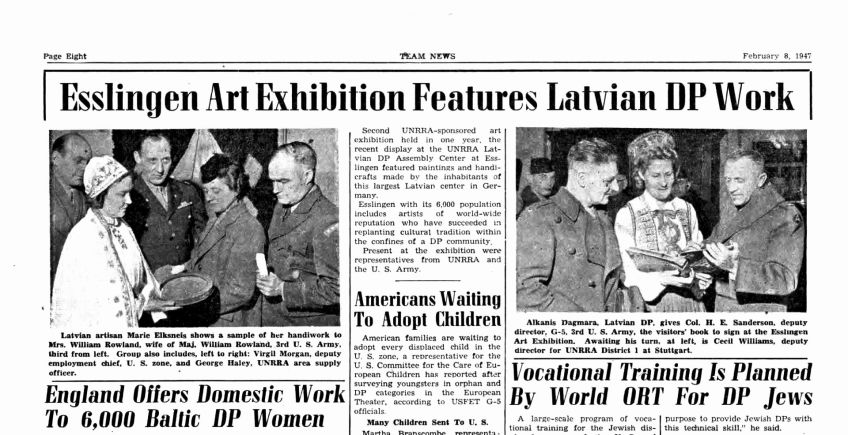Latvian refugee life at Esslingen
The Displaced Persons (DP) camp at Esslingen am Neckar, that is Esslingen on the Neckar river, was the largest Latvian-population DP camp. An April 13, 1946 UNRRA report of assembly centers in the American Zone put the camp population as of March 30th at: 1 Lithuanian, 4 Estonians, 5,606 Latvians, 2 Jews, 80 others, with "Total A.C." of 5,691, and "Total Team" of 5,894. (Esslingen was administered within 1st DISTRICT - STUTTGART, 9th Infantry Division Area.) This was more than double the Latvian population of any other DP camp at the time.
One might mistakenly romanticize the hubbub of activity at Esslingen — even commemorated in a Latvian musical set against the backdrop of DP camp life. Below, Soviet apparatchiks attempt to entice Latvians to return to their "dzimtene", land of their birth — all they have to do is sign the sheet and all will be forgiven, everything confiscated returned. As is commented after the song, Latvians did not take the Soviets up on their offer, and the West was quick to realize that the Soviet Union was not a friend. Latvian refusal to return did not prevent Soviet propaganda from subsequently dispelling the "lie" of Soviet oppression with "success stories" of Latvians who did return to the USSR.
The reality was there was no going home. Latvians were "citizens" of the USSR. Thus, refugees were "defectors" and "traitors." Many, such as Peters' parents, had been slated for future deportation to the Gulag. It's not paranoia if your fear is grounded in reality.
Not only had they lost their homeland, but refugee Latvians feared their compatriots left behind would be Russified and assimilated. Preserving and passing on language, traditions, arts, crafts, literature... was a moral imperative to ensure the survival of Latvian culture. It was also an overt act of defiance against the Soviet regime. Lastly, DP'ers were acutely aware of the need to prove themselves industrious and reliable, to demonstrate their worth to the West so they could be welcomed as constructive contributors, not burdens, to society.
In its 30 pages of text and photographs, An UNRRA Assembly Centre — ESSLINGEN o/NECKAR offers a glimpse into Latvian DP life in the aftermath of WWII.
Read more
- See DP era references in our Exile Experience section.
- About Esslingen DP campLife was far from ideal, yet in many ways, for Latvians, Esslingen represented the ideal of DP camp life.
- PrefaceRené Pinczon du Sel, Director UNRRA Assembly Centre Esslingen, introduces the booklet.
- Growth of the CentreIn his first "chapter" of The Life of the Latvians in Esslingen, author Fēliks Krusa (1897-1967) discusses the town and its growing refugee center.
- Professions and occupations represented by members of the CentreOccupational and other demographics of the camp population.
- “The White House”The headquarters of UNRRA Team 208.
- Administration of the CentreUNRRA allows Latvians to create their own administrative offices: the Latvian Council (50 elected representatives) and the Board of the Committee, also elected.
- Field of education and cultureKindergartens, elementary and high school, technical high school, trade school, a University extension,.... The focus is for Latvians, regardless of their prior occupation, to learn a "practical profession," but that does not impede creativity: Latvians are active in theatre, music, literature, fine arts, and arts and crafts.
- Work is a blessingTransforming dumps into sports fields, repairing watches (making spare parts by hand), creating household utensils out of old tin cans, repairing radios and appliances, vulcanizing rubber for UNRRA car tires — every able-bodied Latvian is busy doing something.
- Promotion of welfareDoctors care for patients, UNRRA police maintain order, rations are weighed out, camp residents are innoculated and clothed, and every individual has to contribute work to the common good.
- Photographs
- Home and schoolBarracks become housing, the library and school are well-attended.
- Arts and craftsProfessors at the art studio, sculpture, woodcarving, folk costumes, and handicrafts.
- ActivitiesBallet, games, theatre, singing, festival, and sport.
- WorkAn assortment of work- and repair-shops.
- SustenanceFood, fuel, home and hearth.
 Gallery
Gallery

